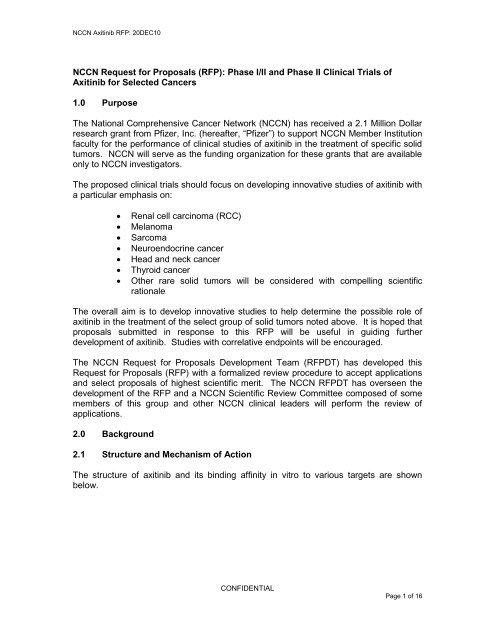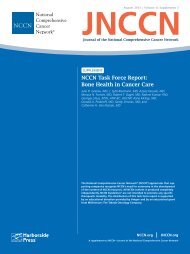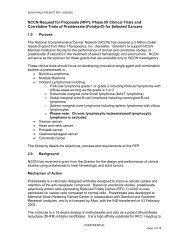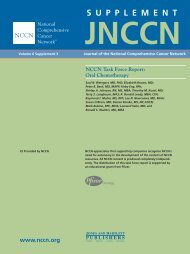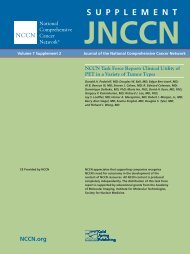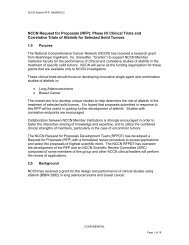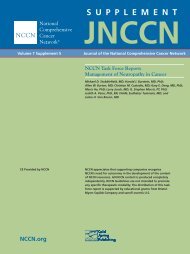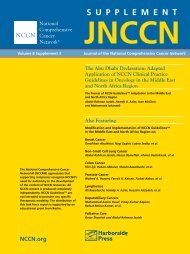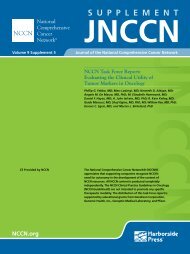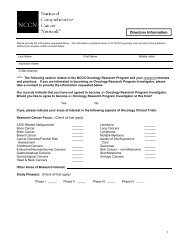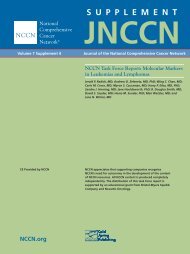Phase I/II and Phase II Clinical Trials of Axitinib for Selected Cancers ...
Phase I/II and Phase II Clinical Trials of Axitinib for Selected Cancers ...
Phase I/II and Phase II Clinical Trials of Axitinib for Selected Cancers ...
- No tags were found...
Create successful ePaper yourself
Turn your PDF publications into a flip-book with our unique Google optimized e-Paper software.
NCCN <strong>Axitinib</strong> RFP: 20DEC10NCCN Request <strong>for</strong> Proposals (RFP): <strong>Phase</strong> I/<strong>II</strong> <strong>and</strong> <strong>Phase</strong> <strong>II</strong> <strong>Clinical</strong> <strong>Trials</strong> <strong>of</strong><strong>Axitinib</strong> <strong>for</strong> <strong>Selected</strong> <strong>Cancers</strong>1.0 PurposeThe National Comprehensive Cancer Network (NCCN) has received a 2.1 Million Dollarresearch grant from Pfizer, Inc. (hereafter, “Pfizer”) to support NCCN Member Institutionfaculty <strong>for</strong> the per<strong>for</strong>mance <strong>of</strong> clinical studies <strong>of</strong> axitinib in the treatment <strong>of</strong> specific solidtumors. NCCN will serve as the funding organization <strong>for</strong> these grants that are availableonly to NCCN investigators.The proposed clinical trials should focus on developing innovative studies <strong>of</strong> axitinib witha particular emphasis on:• Renal cell carcinoma (RCC)• Melanoma• Sarcoma• Neuroendocrine cancer• Head <strong>and</strong> neck cancer• Thyroid cancer• Other rare solid tumors will be considered with compelling scientificrationaleThe overall aim is to develop innovative studies to help determine the possible role <strong>of</strong>axitinib in the treatment <strong>of</strong> the select group <strong>of</strong> solid tumors noted above. It is hoped thatproposals submitted in response to this RFP will be useful in guiding furtherdevelopment <strong>of</strong> axitinib. Studies with correlative endpoints will be encouraged.The NCCN Request <strong>for</strong> Proposals Development Team (RFPDT) has developed thisRequest <strong>for</strong> Proposals (RFP) with a <strong>for</strong>malized review procedure to accept applications<strong>and</strong> select proposals <strong>of</strong> highest scientific merit. The NCCN RFPDT has overseen thedevelopment <strong>of</strong> the RFP <strong>and</strong> a NCCN Scientific Review Committee composed <strong>of</strong> somemembers <strong>of</strong> this group <strong>and</strong> other NCCN clinical leaders will per<strong>for</strong>m the review <strong>of</strong>applications.2.0 Background2.1 Structure <strong>and</strong> Mechanism <strong>of</strong> ActionThe structure <strong>of</strong> axitinib <strong>and</strong> its binding affinity in vitro to various targets are shownbelow.CONFIDENTIALPage 1 <strong>of</strong> 16
NCCN <strong>Axitinib</strong> RFP: 20DEC10<strong>Axitinib</strong> (AG-013736) is an oral, potent <strong>and</strong> selective inhibitor <strong>of</strong> vascular endothelialgrowth factor (VEGF) receptors 1, 2 <strong>and</strong> 3. In kinase assays, axitinib was shown to be apotent <strong>and</strong> ATP-competitive inhibitor <strong>of</strong> receptor tyrosine kinases (RTK) <strong>of</strong> VEGFreceptors 1, 2 <strong>and</strong> 3 , but not a potent inhibitor <strong>of</strong> the closely related kinases <strong>of</strong> FGFR-1,Flt-3, Tie-2 or CSFR-1 <strong>and</strong> was inactive against most kinases <strong>of</strong> distant families in thekinome (1, 2).Table 1. Receptor tyrosine kinase affinities <strong>and</strong> selectivity <strong>of</strong> axitinib (2)TargetVEGFR-2VEGFR-1VEGFR-3PDGFR-βKITPDGFR-αCSF-1RFGFR-1Flt3Cell potency(IC 50 , nM)0.20.10.1-0.31.61.75.073231>1000<strong>Axitinib</strong> has no measurable kinase activity against RET, cMet, EGFR, <strong>and</strong> many otherRTKs at ≥ 1 uM. Key metabolites <strong>of</strong> axitinib do not have significant activity againstVEGF <strong>and</strong> PDGF RTKs.2.2 <strong>Clinical</strong> Pharmacology <strong>and</strong> Safety Experience in HumansHuman studies have shown that axitinib is absorbed within 4 hours following oral dosingwith a mean absolute bioavailability <strong>of</strong> 58%. <strong>Axitinib</strong> is highly protein bound (>99%), withno change in protein binding with hepatic impairment. Both the major human circulatingplasma metabolites (the sulfoxide <strong>and</strong> glucuronide) are inactive. The elimination <strong>of</strong>axitinib is predominantly hepatobiliary <strong>and</strong> the drug has a short plasma half-life (2.5-6.1hours) (1, 3).Common adverse events observed in patients treated with axitinib include fatigue,hypertension, proteinuria, hoarseness <strong>and</strong> diarrhea.CONFIDENTIALPage 2 <strong>of</strong> 16
NCCN <strong>Axitinib</strong> RFP: 20DEC10Safety Review <strong>of</strong> Pooled Single Agent <strong>Axitinib</strong> Studies:Table 2 summarizes the treatment-emergent adverse events in (≥10%) cancer subjectswho received single agent axitinib regardless <strong>of</strong> whether the event was reported asrelated to axitinib treatment or other cause. The combined results are summarized,including <strong>Phase</strong> I studies in subjects with various solid tumors, thyroid cancermelanoma, non-small cell lung cancer (NSCLC), <strong>and</strong> RCC. Only data from thepreviously treated (2 nd line) patients with advanced RCC was included. No data from astudy <strong>of</strong> treatment-naïve (1 st line) patients were included. One study was excluded sinceit involved subjects with hematological malignancies, <strong>and</strong> the first-in-human (FIH) <strong>Phase</strong>I study was excluded since a number <strong>of</strong> patients received starting doses above therecommended starting dose <strong>of</strong> 5 mg BID.Overall, the adverse events reported in axitinib clinical studies are consideredmanageable, generally reversible <strong>and</strong> expected <strong>for</strong> this class <strong>of</strong> agents. For singleagentaxitinib, the most common adverse events reported from 515 cancer subjectsregardless <strong>of</strong> causality included fatigue (284 subjects, 55.1%), diarrhea (254 subjects,49.3%), hypertension (246 subjects, 47.8%), anorexia (197 subjects, 38.3%), nausea(177 subjects, 34.4%), dysphonia (175 subjects, 34.0%), palmar-plantarerythrodysaesthesia syndrome (134 subjects, 26.0%), weight decreased (132 subjects,25.6%), headache (122 subjects, 23.7%), cough (113 subjects, 21.9%), <strong>and</strong> constipation(109 subjects, 21.2%). Additionally, proteinuria <strong>and</strong> hypothyroidism were reported asadverse events in 95 subjects (18.4%) <strong>and</strong> 71 subjects (13.8%), respectively. Grade 3+events occurred most frequently <strong>for</strong> hypertension (92 subjects, 17.9%) <strong>and</strong> fatigue(56 subjects, 10.9%).CONFIDENTIALPage 3 <strong>of</strong> 16
NCCN <strong>Axitinib</strong> RFP: 20DEC10Table 2 Treatment-Emergent, All-Causality Adverse Events Summarized byDescending Frequency Occurring in at Least 10% <strong>of</strong> Subjects with Solid TumorsReceiving Single-Agent <strong>Axitinib</strong>Solid TumorSingle-Agent(N =515)MedDRA Preferred TermAll Gradesn (%)Grade 3+n (%)Fatigue 284 (55.1) 56 (10.9)Diarrhoea 254 (49.3) 29 (5.6)Hypertension 246 (47.8) 92 (17.9)Anorexia 197 (38.3) 12 (2.3)Nausea 177 (34.4) 6 (1.2)Dysphonia 175 (34.0) 0 (0.0)Palmar-plantar erythrodysaesthesiasyndrome 134 (26.0) 33 (6.4)Weight decreased 132 (25.6) 19 (3.7)Headache 122 (23.7) 8 (1.6)Cough 113 (21.9) 5 (1.0)Constipation 109 (21.2) 2 (0.4)Dyspnoea 102 (19.8) 32 (6.2)Arthralgia 100 (19.4) 11 (2.1)Proteinuria 95 (18.4) 15 (2.9)Vomiting 93 (18.1) 6 (1.2)Pain in extremity 91 (17.7) 11 (2.1)Stomatitis 81 (15.7) 7 (1.4)Rash 79 (15.3) 2 (0.4)Mucosal inflammation 78 (15.1) 3 (0.6)Back pain 75 (14.6) 9 (1.7)Dyspepsia 75 (14.6) 1 (0.2)Abdominal pain 71 (13.8) 16 (3.1)Hypothyroidism 71 (13.8) 0 (0.0)Dizziness 62 (12.0) 2 (0.4)Dysgeusia 61 (11.8) 0 (0.0)Dry skin 57 (11.1) 1 (0.2)Epistaxis 55 (10.7) 0 (0.0)Insomnia 53 (10.3) 0 (0.0)Musculoskeletal pain 53 (10.3) 5 (1.0)Oedema peripheral 53 (10.3) 0 (0.0)Pyrexia 53 (10.3) 0 (0.0)Data in Table 2 represents combined safety data from individual studiesLaboratory test results, summarized by maximum grade <strong>for</strong> subjects with solid tumorswho received single-agent axitinib are presented in Table 3. Grade 3 or 4 hyponatremiawas reported in 22 subjects (4.8%), elevations in SGOT (AST) in 13 subjects (2.9%),hyperglycemia in 22 subjects (4.8%), proteinuria in 14 subjects (2.9%), creatinineincreases in 4 subjects (0.9%), lymphopenia in 36 subjects (8.5%), thrombocytopenia in2 subjects (0.4%), <strong>and</strong> neutropenia in 5 subjects (1.1%).CONFIDENTIALPage 4 <strong>of</strong> 16
NCCN <strong>Axitinib</strong> RFP: 20DEC10Table 3 Laboratory Test Results Reported <strong>for</strong> Subjects with Solid TumorsReceiving Single-Agent <strong>Axitinib</strong>n (%) a at Maximum GradeGroup/Parameter b N Grade 1 Grade 2 Grade 3 Grade 4 TotalChemistryAmylase 88 16 (18.2) 3 (3.4) 2 (2.3) 0 (0.0) 21 (23.9)Aspartate Aminotransferase(AST) 456 131 (28.7) 28 (6.1) 13 (2.9) 0 (0.0) 172 (37.7)Alanine Aminotransferase(ALT) 456 109 (23.9) 36 (7.9) 10 (2.2) 0 (0.0) 155 (34.0)Bilirubin (Total) 456 58 (12.7) 23 (5.0) 1 (0.2) 1 (0.2) 83 (18.2)Alkaline Phosphatase 456 141 (30.9) 30 (6.6) 7 (1.5) 0 (0.0) 178 (39.0)Bicarbonate 342 101 (29.5) 9 (2.6) 1 (0.3) 0 (0.0) 111 (32.5)Creatinine 456 141 (30.9) 31 (6.8) 1 (0.2) 3 (0.7) 176 (38.6)Creatine Kinase 7 2 (28.6) 0 (0.0) 0 0.0) 0 (0.0) 2 (28.6)Hypoalbuminemia 456 132 (28.9) 43 (9.4) 13 (2.9) 0 (0.0) 188 (41.2)Hypernatremia 456 22 (4.8) 1 (0.2) 0 (0.0) 0 (0.0) 23 (5.0)Hyponatremia 456 119 (26.1) 0 (0.0) 22 (4.8) 0 (0.0) 141 (30.9)Hyperkalemia 456 90 (19.7) 29 (6.4) 9 (2.0) 0 (0.0) 128 (28.1)Hypokalemia 456 58 (12.7) 0 (0.0) 7 (1.5) 0 (0.0) 65 (14.3)Hypercalcemia 240 31 (12.9) 2 (0.8) 1 (0.4) 1 (0.4) 35 (14.6)Hypocalcemia 240 40 (16.7) 12 (5.0) 2 (0.8) 2 (0.8) 56 (23.3)Hyperglycemia 456 200 (43.9) 63 (13.8) 16 (3.5) 6 (1.3) 285 (62.5)Hypoglycemia 456 55 (12.1) 13 (2.9) 2 (0.4) 1 (0.2) 71 (15.6)Hypophosphatemia 69 0 (0.0) 6 (8.7) 2 (2.9) 0 (0.0) 8 (11.6)-Lipase 88 10 (11.4) 3 (3.4) 3 (3.4) 1 (1.1) 17 (19.3)HematologyHemoglobin 456 170 (37.3) 36 (7.9) 1 (0.2) 11 (2.4) 218 (47.8)Platelets 454 100 (22.0) 4 (0.9) 1 (0.2) 1 (0.2) 106 (23.3)White Blood Cells 456 74 (16.2) 15 (3.3) 0 (0.0) 2 (0.4) 91 (20.0)Neutrophils (Abs) 454 40 (8.8) 9 (2.0) 4 (0.9) 1 (0.2) 54 (11.9)Lymphocytes (Abs) 423 85 (20.1) 75 (17.7) 33 (7.8) 3 (0.7) 196 (46.3)UrinalysisUrine Protein 476 73 (15.3) 88 (18.5) 14 (2.9) 0 (0.0) 175 (36.8)Data in Table 3 represents combined laboratory data from individual studiesa Number <strong>of</strong> subjects at their maximum after-dosing gradeOnly laboratory values which fall within CTCAE grading criteria are included<strong>Axitinib</strong> chemotherapy combination studies:No pharmacokinetic interactions have been observed when axitinib was administered incombination with the following chemotherapy drugs: paclitaxel, cisplatin, carboplatin,oxaliplatin, 5-fluorouracil, irinotecan, pemetrexed or gemcitabine (1).There has been limited experience with axitinib in combination with other agents.Appendix A summarizes the experience to date <strong>of</strong> axitinib combination studies.2.3 Experience in Specific DiseasesIn the <strong>Phase</strong> I study <strong>of</strong> axitinib, the maximum tolerated dose <strong>and</strong> recommended <strong>Phase</strong> <strong>II</strong>dose <strong>of</strong> axitinib was 5 mg bid. Objective radiographic responses were seen in renal cellcarcinoma (n = 2) <strong>and</strong> adenoid cystic carcinoma (n=1) (3). In subsequent <strong>Phase</strong> <strong>II</strong>CONFIDENTIALPage 5 <strong>of</strong> 16
NCCN <strong>Axitinib</strong> RFP: 20DEC10studies, axitinib has been evaluated in renal cell carcinoma, non-small cell lung cancer,thyroid cancer, melanoma, <strong>and</strong> colorectal carcinoma. A brief overview <strong>of</strong> the clinicaldata from these trials is outlined below.2.3.1 Renal cell carcinomaThe design <strong>of</strong> axitinib trials in metastatic renal cell carcinoma (mRCC) aredisplayed in Appendix A.A <strong>Phase</strong> <strong>II</strong> trial <strong>of</strong> axitinib in 52 patients with cytokine refractory RCCdemonstrated an objective response rate <strong>of</strong> 44.2%, with a time to treatmentfailure <strong>of</strong> 15.7 months. The overall survival in this trial was 29.9 months (4).In a <strong>Phase</strong> <strong>II</strong> trial <strong>of</strong> axitinib in sorafenib-refractory mRCC showed an objectiveresponse rate <strong>of</strong> 22.6%. The progression-free <strong>and</strong> overall survival in this trialwere 7.4 <strong>and</strong> 13.6 months respectively (5).The three r<strong>and</strong>omized trials in mRCC are shown in Appendix A. A November 19,2010, press release reported a <strong>Phase</strong> <strong>II</strong>I trial that r<strong>and</strong>omized patients withmRCC, who had failed one prior line <strong>of</strong> systemic therapy, to receive eitheraxitinib or sorafenib had met its primary endpoint <strong>of</strong> progression free survival(PFS).2.3.2 MelanomaA <strong>Phase</strong> <strong>II</strong> trial <strong>of</strong> axitinib in 32 patients with metastatic melanoma demonstratedan objective response rate <strong>of</strong> 15.6% <strong>and</strong> a median PFS <strong>of</strong> 2.3 months. Themedian overall survival was 6.8 months.2.3.3 Thyroid cancerA <strong>Phase</strong> <strong>II</strong> trial <strong>of</strong> axitinib in 60 patients with advanced thyroid cancer showed anobjective response rate <strong>of</strong> 30% with a median progression-free survival <strong>of</strong> 18.1months. In this trial 8 patients (13%) discontinued axitinib due to adverse events.Notably, objective responses were observed in all histological subtypes (6).2.3.4 Neuroendocrine cancer, Sarcoma <strong>and</strong> Head <strong>and</strong> Neck <strong>Cancers</strong>Data is lacking in neuroendocrine cancer, sarcoma <strong>and</strong> head <strong>and</strong> neck cancers,but these tumor types are <strong>of</strong> interest.2.3.5 Potential biomarkersPharmacokinetic data from two <strong>Phase</strong> <strong>II</strong> trials in cytokine-refractory mRCC <strong>and</strong> 8single dose healthy volunteer trials have been studied (9). For the 109 RCCpatients, mean steady-state area under the plasma concentration-time curve(AUC) at the end <strong>of</strong> cycle one <strong>and</strong> the diastolic blood pressure during axitinibtherapy were evaluated as predictors <strong>of</strong> clinical efficacy. The median overallsurvival <strong>for</strong> patients with at least one diastolic blood pressure measurement ≥90mmHg during axitinib treatment (n=59) was 130 weeks compared to 42 weeks inthose who did not experience diastolic blood pressure elevation greater than 90CONFIDENTIALPage 6 <strong>of</strong> 16
NCCN <strong>Axitinib</strong> RFP: 20DEC10mmHg (n=50), p
NCCN <strong>Axitinib</strong> RFP: 20DEC103.2. In diseases where extensive clinical research has already been per<strong>for</strong>med toaccess efficacy (e.g. mRCC), studies focusing on evaluation <strong>of</strong> mechanism, identification<strong>of</strong> predictive markers, evaluation <strong>of</strong> resistance, <strong>and</strong> management <strong>of</strong> drug toxicities areencouraged. Alternatively, studies focusing on particular sub-populations (e.g. patientswith brain metastases or patients with renal insufficiency) are also encouraged.3.3. Since axitinib is not FDA approved at the time <strong>of</strong> this RFP, the investigator will berequired to hold an IND <strong>and</strong> cross file against Pfizer’s IND (See Section 6.2.1). Singlecenterstudies may be preferable <strong>for</strong> reasons <strong>of</strong> expedience; however, multi-centercollaboration may be necessary <strong>for</strong> studies <strong>of</strong> rare cancers or rare cancer-subsets.Collaboration with non-NCCN institutions is permitted.If you need additional in<strong>for</strong>mation regarding whether a concept is already planned orfunded, please send an email to ORPProposals@nccn.org.4.0 Study Time FramesAll approved studies are expected to commence, which is defined as the first patientreceiving the first dose <strong>of</strong> study drug(s), within six (6) months <strong>and</strong> no later than nine (9)months <strong>of</strong> notice <strong>of</strong> study approval by NCCN <strong>and</strong> are to be completed within two (2)years <strong>of</strong> commencement. A manuscript must be submitted to NCCN <strong>for</strong> review no laterthan six (6) months after study endpoint achieved or termination <strong>of</strong> the study. Thesestudies will be given as described in Section 9.0 <strong>and</strong> should be designed with subjectnumber commensurate with study time frames <strong>and</strong> funding.Studies <strong>for</strong> rare cancers or those that require larger number <strong>of</strong> patients <strong>for</strong> statisticalpower should consider being a multi-institutional trial. St<strong>and</strong>-alone <strong>Phase</strong> I studies willnot be accepted.The following types <strong>of</strong> studies will be accepted <strong>for</strong> review:• Single-arm <strong>Phase</strong> <strong>II</strong> studies are expected to explore new approaches that can betested in larger confirmatory studies if positive results are obtained. It isexpected that these studies will complete accrual within 2 years <strong>of</strong>commencement. To meet this accrual goal, single-arm <strong>Phase</strong> <strong>II</strong> trials may bemulti-institutional. Data management <strong>and</strong> monitoring <strong>of</strong> studies should becoordinated by the applying institution. Additional funding <strong>for</strong> the lead institutionmay be requested to support the additional resources required <strong>for</strong> this activity, ifthe study involves multi-institutional participation.• <strong>Phase</strong> I/<strong>II</strong> studies are expected to explore new approaches that can be tested inlarger confirmatory studies if positive results are obtained. <strong>Phase</strong> I/<strong>II</strong> studiescombining axitinib with other targeted agents will be considered. It is expectedthat these studies will complete accrual within 2 years <strong>of</strong> commencement.• R<strong>and</strong>omized <strong>Phase</strong> <strong>II</strong> multi-institutional studies with an estimated 2-yearcompletion. Multi-institutional data management <strong>and</strong> monitoring <strong>of</strong> these studiesshould be coordinated by the lead institution. Additional funding <strong>for</strong> the leadinstitution may be requested to support the additional resources required <strong>for</strong> thisactivity.CONFIDENTIALPage 8 <strong>of</strong> 16
NCCN <strong>Axitinib</strong> RFP: 20DEC105.0 ProposalsIn order to respond to the RFP, investigators will submit a proposal in the <strong>for</strong>matdelineated below to NCCN, which will be evaluated by the NCCN Scientific ReviewCommittee (SRC).Proposals are required to be submitted by the institution’s Office <strong>of</strong> SponsoredResearch <strong>and</strong> include a letter <strong>of</strong> support from the governing groups <strong>of</strong> theinstitution verifying:1) The proposal has Department Chair/Division approval;2) Institutional budgetary review <strong>and</strong> approval;3) Verification <strong>of</strong> the priority status <strong>of</strong> the research (there are no competing trials <strong>of</strong>higher priority);4) The study includes a statistical co-investigator;5) Contact in<strong>for</strong>mation <strong>for</strong> the contract representative assigned to the study;6) Documentation to support feasibility with at least one <strong>of</strong> the following:• Letter from institution’s Feasibility Committee• Documentation by previous studies <strong>and</strong> accrual (if available, publications <strong>and</strong>abstractsLetters should be addressed to William T. McGivney, PhD, CEO, NationalComprehensive Cancer Network, 275 Commerce Drive, Suite 300, Fort Washington, PA19034.Proposals will provide concise documentation <strong>of</strong> the research plan <strong>and</strong> are to bemodeled after the NCI Letter <strong>of</strong> Intent. The proposal is expected to contain sufficientin<strong>for</strong>mation to allow the reviewers to fully assess the scientific rigor <strong>of</strong> the proposedstudy. A full research project plan may be submitted as an attachment to a proposal.The proposal should contain detailed in<strong>for</strong>mation regarding the following areas:5.1 <strong>Clinical</strong> <strong>Trials</strong> (Maximum 5 Pages)A. Title/Tumor TypeB. Investigators <strong>and</strong> institutional affiliationsC. Hypothesis with primary <strong>and</strong> secondary objectivesD. Background In<strong>for</strong>mationE. Research designF. Study populationi. Stageii. Major inclusions/exclusionsG. Treatment planH. Endpoints/Statistical analysisI. Feasibilityi. Estimated time <strong>of</strong> completion/monthly accrualii. Previous experience with trials that had similar tumor type,phase <strong>of</strong> study or prior therapyiii. Collaborators’ experience, including affiliatesiv. Competing trials: List all active, approved or in-review studiesat your institution <strong>for</strong> which the same patient population iseligibleCONFIDENTIALPage 9 <strong>of</strong> 16
NCCN <strong>Axitinib</strong> RFP: 20DEC10v. Projected Accrual Dates (Month/Year)vi. In<strong>for</strong>mation listed in 5.0(6)5.2 Correlative Studies (Maximum 3 Pages)A. Hypothesis (include relevant background studies)B. Preliminary dataC. Study design (include methods <strong>for</strong> obtaining samples, administering<strong>for</strong>ms, or per<strong>for</strong>ming radiologic studies)D. Study populationE. MethodologyF. Analytic planG. Feasibilityi. Accrualii. Specimen acquisition5.3 Budget using NCI <strong>for</strong>matA. Breakdown by major cost categories.B. Justification <strong>of</strong> major costs with enough detail to demonstrate howfunding <strong>for</strong> major elements in the study will be allocated.C. For combined clinical <strong>and</strong> correlative studies, separate budgets <strong>for</strong>each component should be submitted.5.4 Ancillary DocumentationA. An NCI <strong>for</strong>mat BioSketch <strong>of</strong> the Principal InvestigatorB. An appendix <strong>of</strong> supportive literature may be provided6.0 Proposal Requirements6.1 SubmissionAll proposals must be submitted via email to ORPProposals@nccn.org<strong>and</strong> are due to the NCCN <strong>of</strong>fice by close <strong>of</strong> business, 5:00 PM (EST) onFebruary 14, 2011.Studies that have safety issues, are already well-funded concepts,or are not consistent with the strategy <strong>for</strong> investigation as written inthis RFP, will not be reviewed by the SRC.For questions or issues, please send an email toORPProposals@nccn.org or call Doreen Walker at (215) 690-0565.NCCN will seek to provide in<strong>for</strong>mation to potential investigators regardingongoing or completed studies <strong>of</strong> axitinib in order to avoid the submission<strong>of</strong> a proposal that is already a well-studied concept.6.2 Requirements6.2.1 IND: Investigators are required to hold INDs <strong>for</strong> studies <strong>and</strong> willbe allowed to cross-reference a filing to Pfizer’s IND as stated in Section3.3.CONFIDENTIALPage 10 <strong>of</strong> 16
NCCN <strong>Axitinib</strong> RFP: 20DEC106.2.2 Human Biological Specimens – All specimens must be obtainedunder in<strong>for</strong>med consent <strong>and</strong> IRB approval appropriate <strong>for</strong> the study. Aletter <strong>of</strong> assurance must be provided to NCCN that the PI’s academicinstitution owns <strong>and</strong> has full rights to the tissue without conflicting claimsfrom a non-Pfizer commercial entity. Compliance with all federalregulations is required.6.2.3 IRB:6.2.3(a) Draft protocols will be reviewed by NCCN <strong>and</strong> Pfizer priorto IRB review. A copy <strong>of</strong> the draft protocol must be submitted to NCCNwithin 4-6 weeks after the study approval letter. The protocol must beconsistent with the approved proposal <strong>and</strong> all reviewer comments mustbe addressed.6.2.3(b) All investigators will submit protocols <strong>for</strong> IRB review <strong>and</strong>document approval to NCCN prior to study activation <strong>and</strong> all collaboratorswill furnish evidence <strong>of</strong> IRB approval. It is expected that IRB review <strong>and</strong>approval be completed within 120 days following NCCN notification <strong>of</strong>funding <strong>for</strong> the project.6.2.3(c) IRB approval documents must be submitted to NCCNprior to study activation <strong>and</strong> all collaborators will also furnish evidence <strong>of</strong>IRB approval.6.2.4 Serious Adverse Event Reporting: All serious adverse events willbe reported to NCCN <strong>and</strong> Pfizer in addition to local regulatory authorities.6.2.5 Institutional Monitoring: All studies will be internally monitored inaccordance with appropriate committees (e.g. institutional Data Safety<strong>and</strong> Monitoring Plan in the case <strong>of</strong> human studies). A copy <strong>of</strong> the DataMonitoring Plan <strong>for</strong> the study must be submitted to NCCN prior to NCCNapproval <strong>of</strong> study activation.6.2.6 Progress Reports: Investigators will provide interim progressreports to NCCN detailing the progress <strong>of</strong> studies quarterly, <strong>and</strong> uponstudy completion. These reports will be used administratively <strong>for</strong>generating investigator payments. If study progress or accrual lagsbehind the expected rate, the Scientific Review Committee (SRC) may beasked <strong>for</strong> suggestions to improve study progress, or alternatively, toterminate the study <strong>and</strong> any further funding.6.2.7 Specimen Transmittal: If specimens are to be transportedextramurally <strong>for</strong> collaborative laboratory studies, all institutionalrequirements <strong>for</strong> safety <strong>and</strong> confidentiality will be met.6.2.8 Investigators Meeting: All studies will be presented by institutionalrepresentatives at an annual NCCN investigator meeting. The purpose <strong>of</strong>this meeting will be to discuss preliminary results <strong>and</strong> develop newresearch initiatives <strong>and</strong> further collaborative activities between NCCNinvestigators <strong>and</strong> Pfizer’s scientific staff. Separate funds will be providedCONFIDENTIALPage 11 <strong>of</strong> 16
NCCN <strong>Axitinib</strong> RFP: 20DEC107.0 Drug Supply<strong>for</strong> attendance at this meeting. Participation by the PIs in these meetingsis a requirement <strong>of</strong> a funded study.6.2.9 Abstracts <strong>and</strong> Publications: Abstracts <strong>for</strong> presentation at scientificmeetings <strong>and</strong> all publications <strong>of</strong> study results will be submitted to NCCN<strong>and</strong> Pfizer <strong>for</strong> review related to protection <strong>of</strong> company’s intellectualproperty <strong>and</strong> confidential in<strong>for</strong>mation prior to any submission.Abstracts must be submitted at least 10 days prior to submission <strong>and</strong>manuscripts at least 30 days prior to submission. Pfizer may delaypublication <strong>and</strong> disclosure <strong>of</strong> the manuscript or abstract <strong>for</strong> up to anadditional sixty (60) days so as to seek patent protection <strong>of</strong> intellectualproperty rights.6.2.10 NCCN institutions <strong>and</strong> investigators will be responsible <strong>for</strong>conducting all studies in accordance with the applicable research plan,GCP Guidelines, <strong>and</strong> all applicable laws <strong>and</strong> regulations. NCCNinstitutions <strong>and</strong> investigators will be responsible <strong>for</strong> all data collection,statistical analysis <strong>and</strong> safety reporting.6.2.11 Investigators must provide reasonable assurance that submittedstudies will be able to reach completion within the time frames specified inSection 4.0.6.2.12 Final protocols must be consistent with approved proposals.Funds will be rescinded if there are significant changes without priorNCCN approval. There will be no exceptions.<strong>Axitinib</strong> will be supplied <strong>and</strong> distributed to sites <strong>for</strong> all approved <strong>and</strong> funded studies byPfizer. No drug will be shipped until NCCN receives all required regulatory documents.8.0 Selection CriteriaProposals will be judged based on the following criteria:1. Scientific value2. Soundness <strong>of</strong> study design3. Feasibility including reasonable assurance <strong>of</strong> achieving intended <strong>and</strong> fullaccrual4. Budgetary reasonableness5. Expected applicability in the evaluation <strong>of</strong> <strong>and</strong> the appropriate use <strong>of</strong>axitinib in selected solid tumors9.0 FundingNCCN <strong>and</strong> its member institutions have an agreement to include a maximum <strong>of</strong> 25%indirect costs <strong>for</strong> trials funded by the NCCN. Direct funding will include all costsincluding investigators’ salaries. For example, $80,000 direct costs, $20,000 indirectcosts <strong>for</strong> a total grant <strong>of</strong> $100,000. Any funds in excess <strong>of</strong> the limits stipulated in thissection <strong>for</strong> direct funding will require detailed justification <strong>and</strong> review.CONFIDENTIALPage 12 <strong>of</strong> 16
NCCN <strong>Axitinib</strong> RFP: 20DEC10<strong>Phase</strong> I /<strong>II</strong> clinical trials will be funded at a cost <strong>of</strong> up to $250,000 (total costs includingdirect costs <strong>and</strong> 25% indirect costs) per trial. Per patient costs will not exceed $8,000per patient. Multi-institutional data management <strong>and</strong> monitoring <strong>of</strong> these studies shouldbe coordinated by the lead institution. Additional funding <strong>for</strong> the lead institution may berequested to support the additional resources required <strong>for</strong> this activity.The Correlative Laboratory studies section <strong>of</strong> the clinical trial will be funded up to a totalcost <strong>of</strong> $100,000 including up to 25% indirect costs.Funding will be disbursed according to the following:<strong>Phase</strong> I/<strong>II</strong> trials:• 25% <strong>of</strong> total award after IRB approval <strong>and</strong> implementation <strong>of</strong> the <strong>Phase</strong> I Study• 35% <strong>of</strong> total award after 50% accrual <strong>of</strong> Study subjects are enrolled in the <strong>Phase</strong><strong>II</strong> Study,• 30% <strong>of</strong> total award after 100% accrual <strong>of</strong> Study subjects to the <strong>Phase</strong> <strong>II</strong> Study• 10% <strong>of</strong> funds will be awarded after submission <strong>of</strong> manuscript <strong>for</strong> publication or afinal summary report <strong>of</strong> the Study<strong>Phase</strong> <strong>II</strong> trials 25% <strong>of</strong> total award <strong>for</strong> such Study after IRB approval <strong>and</strong> implementation• 35% <strong>of</strong> total award after 50% accrual• 30% <strong>of</strong> total award after 100% accrual• 10% <strong>of</strong> funds will be awarded after submission <strong>of</strong> a final summary report ormanuscript <strong>for</strong> publicationThe goal is to have rapid submission <strong>of</strong> a manuscript so as to have the data available tothe wider scientific community.Studies that do not meet the time frame requirements as stipulated in Section 4.0will have funds rescinded <strong>and</strong> will be required to return any <strong>and</strong> all unused fundspreviously disbursed.10.0 Study AgreementA study agreement will be signed between NCCN <strong>and</strong> each participating institution.All a<strong>for</strong>ementioned points between NCCN <strong>and</strong> the participating institution must be strictlyadhered to.CONFIDENTIALPage 13 <strong>of</strong> 16
NCCN <strong>Axitinib</strong> RFP: 20DEC10APPENDIX ATable A1 Pfizer <strong>Clinical</strong> Development <strong>of</strong> <strong>Axitinib</strong>Tumor type Trial design Recruitment statusAdvanced Non-Small Cell LungCancerAdvanced Non-Small Cell LungCancerMetastatic colorectal carcinomaMetastatic colorectal carcinomaThyroid cancerRenal cell carcinoma <strong>Phase</strong> <strong>II</strong> CompletedHepatocellular carcinoma<strong>Phase</strong> <strong>II</strong> study <strong>of</strong> second-line Scheduled to opensingle agent axitinib after failure <strong>of</strong>one prior antiangiogenic therapyAdvanced Non-Small Cell LungCancer<strong>Phase</strong> <strong>II</strong> study <strong>of</strong> first-line axitinib+ paclitaxel/carboplatin vs.bevacizumab +paclitaxel/carboplatin in non-Completedsquamous NSCLC<strong>Phase</strong> I/ <strong>II</strong> study <strong>of</strong> first-linepemetrexed/cisplatin +/– axitinibin non-squamous NSCLC<strong>Phase</strong> <strong>II</strong> study <strong>of</strong> first-line axitinib+ gemcitabine/cisplatin insquamous NSCLC<strong>Phase</strong> I/ <strong>II</strong> study <strong>of</strong> first-lineaxitinib + FOLFOX +bevacizumab vs. axitinib +FOLFOX vs. bevacizumab +FOLFOX<strong>Phase</strong> <strong>II</strong> study <strong>of</strong> second-lineaxitinib + FOLFOX or FOLFIRI vs.bevacizumab + FOLFOX orFOLFIRI<strong>Phase</strong> <strong>II</strong> study in refractory,metastatic or locally advanceddiseaseCompletedCompletedCompletedCompletedCompletedThyroid cancer <strong>Phase</strong> <strong>II</strong> trial in 2 nd -line OngoingAdvanced solid tumors <strong>Phase</strong> I study <strong>of</strong> axitinib +chemotherapy in patientswith relapsed, advanced solidtumorsCompletedAdvanced solid tumorsAdvanced solid tumorsClear cell Renal Cell Carcinoma(RCC) -failed one prior systemictherapyClear cell RCC with no priorsystemic therapyClear cell RCC with no priortherapy or failed one line<strong>Phase</strong> I study <strong>of</strong> axitinib inJapanese patients with relapsed,advanced solid tumors<strong>Phase</strong> I study <strong>of</strong> single <strong>and</strong>multiple doses <strong>of</strong> axitinib<strong>Phase</strong> <strong>II</strong>I trial <strong>of</strong> axitinib vs.sorafenib<strong>Phase</strong> <strong>II</strong> study:<strong>Axitinib</strong> 5mg bid vs. axitinib 5mgbid + DT vs. axitinib 5mg bid +placebo DT<strong>Phase</strong> <strong>II</strong> trial <strong>of</strong> axitinib vs.sorafenibCompletedCompletedCompletedCompletedEnrolling in the 1 st line part <strong>of</strong>studyMetastatic RCC with failed 1 priorline cytokine-based therapy (Noother systemic therapy)Metastatic RCC-status postnephrectomy. Failed priorsorafenib-based therapyClear cell RCC/Postnephrectomy/Failed first-linecytokine therapy<strong>Phase</strong> <strong>II</strong> trial <strong>of</strong> axitinib 5mg bidwith dose titration<strong>Phase</strong> <strong>II</strong> trial <strong>of</strong> axitinib 5mg bidwith dose titration<strong>Phase</strong> <strong>II</strong> study <strong>of</strong> axitinib 5mg bidto 10 mg bidCompletedCompletedCompletedCONFIDENTIALPage 14 <strong>of</strong> 16
NCCN <strong>Axitinib</strong> RFP: 20DEC10APPENDIX ATable A2 <strong>Axitinib</strong> Investigator Initiated StudiesTumor Type Trial Design Recruitment StatusNeuroendocrineMelanomaMelanomaRenal cell carcinomaRenal cell carcinomaMetastatic renal cell carcinomaMelanomaSarcoma<strong>Phase</strong> <strong>II</strong> r<strong>and</strong>omized double-blindstudy <strong>of</strong> Santostatin LAR incombination with <strong>Axitinib</strong> versusPlacebo in patients withprogressive advanced welldifferentiatedneuroendocrinecarcinomas <strong>of</strong> non-pancreaticorigin<strong>Phase</strong> <strong>II</strong> clinical trial <strong>of</strong> daily oralaxitinib (5 mg) <strong>for</strong> the adjuvanttreatment <strong>of</strong> stage <strong>II</strong>I-IVmelanomaA <strong>Phase</strong> <strong>II</strong> Trial <strong>of</strong> Met<strong>for</strong>min <strong>and</strong><strong>Axitinib</strong> in BRAF MutatedAdvanced Melanoma (MAXIM)Effect <strong>of</strong> Neoadjuvant <strong>Axitinib</strong> OnPrimary Tumor Response InLocally Advanced Clear Cell RCC<strong>Phase</strong> <strong>II</strong> study <strong>of</strong> <strong>Axitinib</strong> <strong>for</strong>downstaging large renal tumorsnot primarily suitable <strong>for</strong> PartialNephrectomyA <strong>Phase</strong> <strong>II</strong> Study Of <strong>Axitinib</strong>Therapy Be<strong>for</strong>e Nephrectomy inMetastatic Renal Cell CancerPilot <strong>Phase</strong> I trial <strong>of</strong> sequential<strong>Axitinib</strong>+ Carboplatin/Paclitaxel inMelanoma with Correlative FLTPETA clinicopathological phase <strong>II</strong>study <strong>of</strong> axitinib in patients withadvanced angiosarcoma <strong>and</strong>other s<strong>of</strong>t tissue sarcomasApprovedApprovedApprovedApprovedApprovedApprovedOngoingOngoingCONFIDENTIALPage 15 <strong>of</strong> 16
NCCN <strong>Axitinib</strong> RFP: 20DEC10References1. Investigator's Brochure: AG-013736. October 2010. Pfizer.2. Hu-Lowe DD, Zou HY, Grazzini ML, et al. Nonclinical antiangiogenesis <strong>and</strong>antitumor activities <strong>of</strong> axitinib (AG-013736), an oral, potent, <strong>and</strong> selective inhibitor<strong>of</strong> growth factor receptor tyrosine kinases 1, 2, 3. Clin Cancer Res.2008;14:7272-83.3. Rugo HS, Herbst RS, Liu G, et al. <strong>Phase</strong> I trial <strong>of</strong> the oral antiangiogenesis agentAG-013736 in patients with advanced solid tumors: pharmacokinetic <strong>and</strong> clinicalresults. J Clin Oncol. 2005;23:5474-83.4. Rixe O, Bukowski R, Michaelson MD, et al. <strong>Axitinib</strong> treatment in patients withcytokine-refractory metastatic renal cell cancer: a phase <strong>II</strong> study. Lancet Oncol.2007;8:975-84.5. Rini BI, Wilding G, Hudes G, et al. <strong>Phase</strong> <strong>II</strong> study <strong>of</strong> axitinib in sorafenibrefractorymetastatic renal cell carcinoma. J Clin Oncol. 2009;27:4462-8.6. Cohen EE, Rosen LS, Vokes EE, et al. <strong>Axitinib</strong> is an active treatment <strong>for</strong> allhistologic subtypes <strong>of</strong> advanced thyroid cancer: results from a phase <strong>II</strong> study. JClin Oncol. 2008;26:4708-13.7. Fruehauf JP, Lutzky J, McDermott D Fea. <strong>Axitinib</strong> (AG-013736) in patients withmetastatic melanoma: a phase <strong>II</strong> study. J Clin Onco 26:2008 (May 20 suppl;abstr 9006).8. Schiller JH, Larson T, Ou SH, et al. Efficacy <strong>and</strong> safety <strong>of</strong> axitinib in patients withadvanced non-small cell lung cancer: results from a phase <strong>II</strong> study. J Clin Oncol.2009;27:3836-41.9. Rixe O, Dutcher J, Motzer R, Wilding G, Stadler WM, Garrett M, Pithavala Y, KimS, Tarazi J, Rini BI. Diastolic blood pressure (dBP) <strong>and</strong> pharmacokinetics (PK) aspredictors <strong>of</strong> axitinib efficacy in metastatic renal cell cancer (mRCC). J Clin Oncol27: 2009 (suppl; abstr 5045).CONFIDENTIALPage 16 <strong>of</strong> 16


